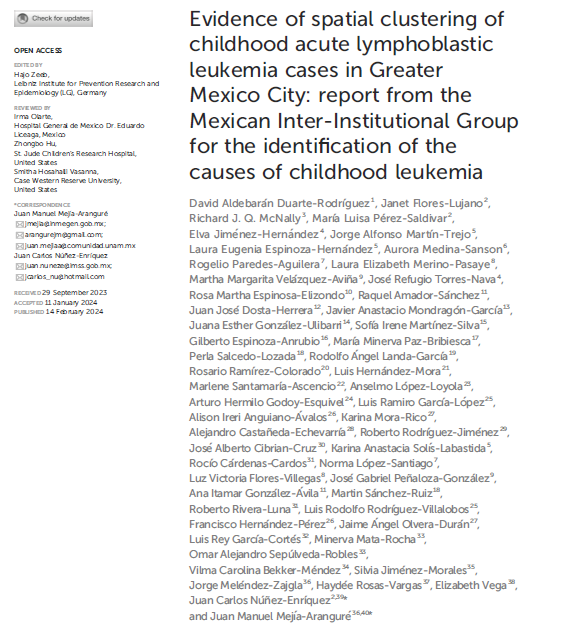
The document is a research article titled “Evidence of Spatial Clustering of Childhood Acute Lymphoblastic Leukemia Cases in Greater Mexico City: report from the Mexican Inter-Institutional Group for the Identification of the Causes of Childhood Leukemia,” published in Frontiers in Oncology on February 14, 2024. It presents a study aimed at exploring the geographical distribution of childhood acute lymphoblastic leukemia (ALL) cases in Greater Mexico City to investigate the potential role of environmental factors in the disease’s etiology. The study utilized a population-based case-control design and employed Kulldorff’s spatial scan statistic to detect spatial clusters (SCs) of ALL cases among children under 18 years. A total of 1054 cases were analyzed, revealing eight significant SCs, suggesting the influence of environmental factors, particularly near electrical installations and former petrochemical facilities. This study contributes to understanding the spatial distribution of childhood ALL in Greater Mexico City and underscores the need for further research to elucidate the environmental hazards associated with the disease.
- Objective: The study aimed to investigate if there’s a spatial pattern in the occurrence of childhood acute lymphoblastic leukemia (ALL) in Greater Mexico City, suggesting environmental factors might influence the disease.
- Design and Participants: It used a population-based case-control design, analyzing 1054 cases of children under 18 diagnosed with ALL, to look for spatial clusters (SCs) where the disease was more prevalent.
- Methodology: The researchers employed Kulldorff’s spatial scan statistic, a statistical test to identify clusters of disease cases over a geographical area. This method helps to find areas where the number of cases is significantly higher than expected, suggesting a potential environmental link.
- Findings: Eight significant spatial clusters were identified, indicating areas with a higher incidence of childhood ALL. These areas were notably near electrical installations and former petrochemical facilities, pointing to potential environmental risks.
- Power Levels: The study’s statistical power refers to its ability to detect true spatial clusters of ALL cases against the background noise of random variation. High power means a greater likelihood of correctly identifying true clusters. The specific statistical power levels used to confirm the significance of identified clusters would depend on the study’s design, including the number of cases analyzed and the methods for adjusting for multiple testing.
- Conclusion: The detection of spatial clusters suggests environmental factors may play a role in the development of childhood ALL in these areas, warranting further investigation into specific hazards.
- Implications: This study underlines the importance of environmental health research in understanding the etiology of childhood ALL and highlights specific areas in Greater Mexico City for further investigation into potential environmental exposures.
Unraveling Childhood Leukemia: A Spatial Perspective from Greater Mexico City
In a groundbreaking study conducted in Greater Mexico City, researchers have taken a significant step towards understanding the environmental factors that may contribute to the occurrence of childhood acute lymphoblastic leukemia (ALL). This research, which scrutinized 1054 cases, aimed to uncover if there’s a spatial pattern to the disease’s prevalence, potentially linked to environmental exposures.
The study employed a meticulous population-based case-control design, focusing on children under 18 diagnosed with ALL. By leveraging Kulldorff’s spatial scan statistic, a sophisticated tool for identifying disease clusters, researchers uncovered eight significant spatial clusters where the disease was notably prevalent. Intriguingly, these clusters were primarily located near electrical installations and former petrochemical facilities, hinting at possible environmental hazards.
Understanding the study’s statistical power is crucial. In this context, “power” refers to the research’s capability to distinguish true spatial clusters from random variations. The higher the power, the more confidently researchers can assert the presence of these clusters, despite the inherent background noise. This aspect underscores the robustness of the study’s findings, although the specific power levels hinge on various factors, including the number of cases and the methodology for statistical adjustments.
The implications of these findings are profound. The identification of spatial clusters points towards environmental factors playing a significant role in the development of childhood ALL in these areas. This revelation not only prompts further investigation into specific environmental hazards but also underscores the critical need for environmental health research in unraveling the etiology of childhood leukemia.
Moreover, the study highlights the importance of monitoring and reducing exposure to potential environmental risks, especially electromagnetic fields (EMFs), which have been a concern around electrical installations. To mitigate EMF exposure, measures such as maintaining distance from electrical appliances, using wired instead of wireless devices when possible, and employing EMF shields can be beneficial. Additionally, measuring EMF levels in living spaces with EMF meters provides a tangible way to assess and manage exposure risks.
This research marks a pivotal step towards understanding and ultimately reducing the environmental risk factors associated with childhood ALL. By pinpointing specific areas for further investigation, the study paves the way for more targeted research and interventions aimed at safeguarding children’s health against environmental hazards.
